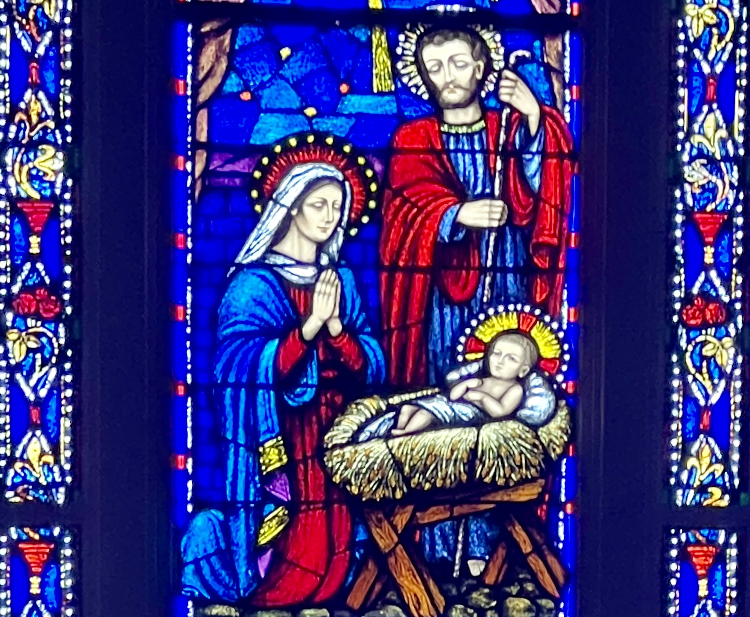“This day is born to you a Savior who is Christ the Lord.” (Lk 2:11)

By Mary Powers
Ten years after the devastating 1906 earthquake, San Francisco hosted the 1915 Panama-Pacific International Exposition celebrating the newly rebuilt city. Constructing a “city within a city” by filling in part of the bay to create the Marina District, the exposition lasted from February to December 1915. The organizers constructed buildings covered in jewels and highlighted the latest inventions, including the first transcontinental telephone call. Daredevil pilots flew the skies and the occasion even included a visit by the Liberty Bell, sent across the country to celebrate the completion of the Panama Canal. Today, the Palace of Fine Arts stands as a reminder of the magnificent event.
In the midst of a city in celebration, a church only blocks from the exposition expanded their Mass hours to accommodate the international crowds. St. Vincent de Paul, originally established by Archbishop Patrick Riordan in 1902 with pastor Father Martin Ryan, had recently completed its church structure at the corner of Green and Steiner Streets, in what is known as “Cow Hollow.” Dedicated Oct. 26, 1913, St. Vincent de Paul Catholic Church served a diverse community, which at times over the years included the military members stationed at the Presidio.
Over time, the parish expanded to include a school run by the Daughters of Charity (sent from St. Louis, Missouri) with a convent and gym.
In 1944, pastor Father James Long wrote to the Archdiocesan Building Commission to request approval for new stained-glass windows for the church. “The present amber glass allows a flood of light to penetrate the building making it garish at times,” said Father Long. “There is practically no color in the building.” Today, Father Long’s vision for the windows is on display — full of color, illuminating events in the Old and New Testaments and honoring the patron saint of the church.
The artist chosen for the project was Carl Huneke of Century Stained Glass Studio in San Francisco. Huneke, a native of Germany, had recently worked with Charles Connick Studios of Boston on installing the windows at Grace Cathedral in San Francisco and designed the windows of St. Mary’s Church (now Cathedral of the Annunciation) in Stockton. According to research conducted by Father John Ring for his history of the parish, Huneke told a reporter in 1953 that it was his love of color that drew him to stained glass, “No other craft deals in light as brilliant or as elemental. … It may seem hard and laborious work to you, but if you love it, as I do, the harder the task is, the better you like it.”
Within the central transept of the church lies the story of the Incarnation mirrored by the sacrifice on Calvary.
The series of Incarnation windows include Old Testament prophesies of the Messiah and their parallel New Testament stories. For example, the lowest scenes of the windows (reading left to right) depict the promise from God in Genesis, “I will put enmity between thee and the woman, and thy seed and her seed.” The Annunciation follows with, “The Holy who shall be born of thee shall be called the Son of God.” Next is the Adoration of the Magi in the third set of windows, “They found the child and His mother, and falling down they adored Him.”
In the center, one finds the pastoral scene from Bethlehem. Over the Nativity sits God the Father surrounded by angels with the Holy Spirit hovering over the manger in blessing and the words from Luke’s Gospel, “This day is born to you a Savior who is Christ the Lord.” Over the biblical windows sits a rose window of the baby Jesus with symbols including a burning candle showing Christ as Light of the World.
Directly across from the windows depicting the expectant hope and joy of the Savior lies the reason for His coming into the world — His saving passion and death on the cross. In the central set of windows, the dominating scene depicts the crucifixion with the words, “It is consummated,” indicating the completion of the old law and sealing of the new covenant.
The series of windows reflect God’s faithfulness to His promises and love for mankind, “For God so loved the world that He gave His only Son, so that everyone who believes in Him might not perish but might have eternal life” (Jn 3:16-17).
St. Vincent de Paul Church is truly a treasure of San Francisco that stands as a testament to an indomitable city. While the jeweled buildings of the exposition no longer exist, the jeweled windows of St. Vincent de Paul continue to illuminate the glorious truths of our redemption.
Mary Powers is the assistant director of communications for the Archdiocese of San Francisco.

